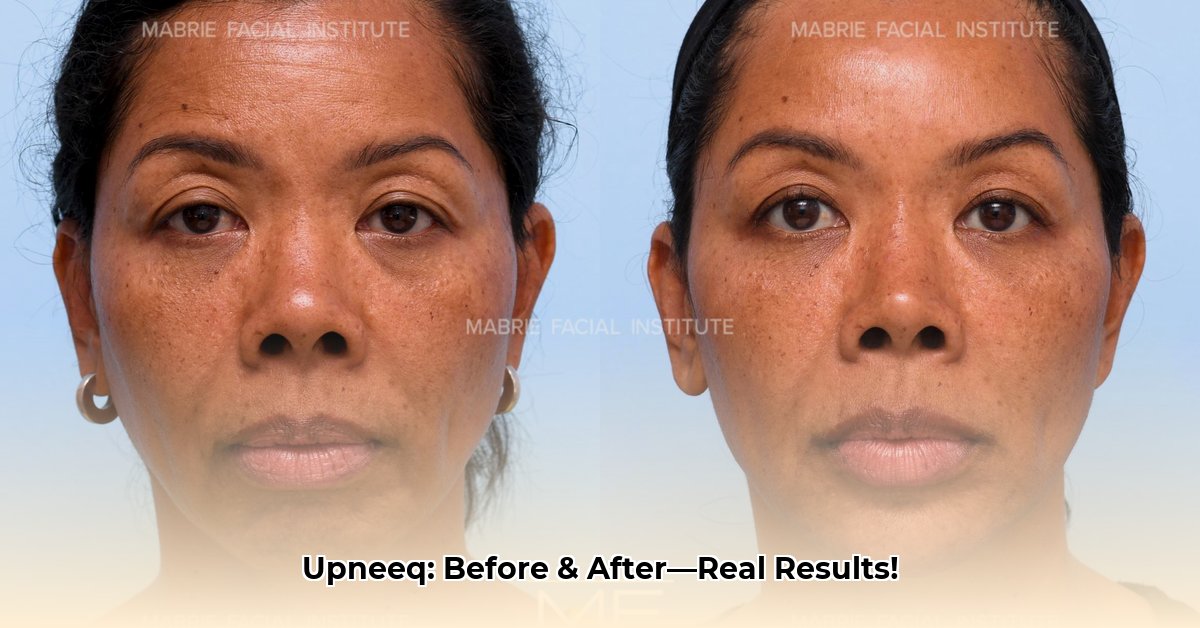Are you considering Upneeq for droopy eyelids? This comprehensive review reveals real Upneeq results, explaining its mechanism, benefits, and key considerations. We’ll explore before-and-after expectations, compare it to alternatives like Botox, address costs, and guide you on discussing it with your doctor. Gain a clearer understanding of Upneeq and confidently determine if it’s the right choice.
Upneeq: What to Expect Before and After Treatment
If droopy eyelids (acquired blepharoptosis) bother you, Upneeq might be a solution. This FDA-approved eye drop offers temporary eyelid lifting, resulting in a more awake and alert appearance. But before obtaining a prescription, understanding its mechanism, potential benefits, side effects, and risks is crucial.
How Upneeq Works: A Targeted Approach for Eyelid Elevation
Upneeq contains oxymetazoline hydrochloride, which stimulates the Müller’s muscle, responsible for lifting the upper eyelid. By causing this muscle to contract, Upneeq provides a subtle lift. This offers a temporary alternative to surgical options. The effects usually manifest within minutes, with the degree of the lift varies from person to person. This treatment only provides short-term results.
Clinical Studies: Assessing Upneeq’s Effectiveness and Visual Improvement
Clinical trials demonstrate Upneeq’s effectiveness in lifting eyelids. Studies reveal that approximately 84% of participants experienced some degree of noticeable improvement in eyelid lift. Additionally, 88% reported enhancements in their upper field of vision. Individual results, however, may vary. Clinical studies show that the average upper eyelid lift with Upneeq is approximately 1 mm.
Upneeq Before & After Photos: Visual Evidence
The impact of Upneeq can be best illustrated through before-and-after photos. A quick online search will yield visuals shared by Upneeq users, showing the subtle yet noticeable difference the medication can achieve. Individual results will vary, so manage your expectations.
Potential Side Effects and Risks
Like any medication, Upneeq carries the risk of potential side effects. The most commonly reported side effects include eye inflammation, redness, dry eye, blurred vision, eye pain upon use, and eye irritation. Headaches may also occur. Contact your eye doctor or healthcare provider if you have adverse reactions or concerns.
It’s crucial to note that Upneeq may affect blood pressure, so individuals with heart disease, uncontrolled high or low blood pressure, or those prone to feeling faint at rest or when standing up should exercise caution. Those with reduced blood flow to the brain or heart or those experiencing dry eyes or mouth due to Sjögren’s syndrome should also use Upneeq with care.
Understanding the Cost and Insurance Coverage
The cost of Upneeq can be a significant factor in your decision-making process. A 45-day supply can range from $220 to $250, translating to approximately $4.90 to $5.56 per day.
Insurance coverage for Upneeq can vary. Some insurance companies may consider it “experimental, investigational, or unproven,” leading to denial of coverage. Discuss costs, potential payment options, and financial assistance programs with your doctor’s office.
Exploring Alternatives: Botox and Surgical Options
While Upneeq offers a non-surgical solution for droopy eyelids, other options are available. Botox injections offer another non-surgical alternative, while blepharoplasty (eyelid surgery) can provide a more permanent solution for severe cases of ptosis or excess skin. Consult with your ophthalmologist to determine the treatment that aligns with your individual needs.
Determining Candidacy: Who Benefits Most From Upneeq?
Upneeq is typically recommended for adults with mild to moderate acquired ptosis. It is not a suitable treatment for congenital ptosis (drooping eyelids present from birth) or drooping caused by other factors like excess skin or nerve problems. An ophthalmologist can evaluate your specific condition and determine if Upneeq is appropriate.
Making an Informed Decision: Weighing Benefits and Risks
Deciding whether to use Upneeq is a personal one that should be made after careful consideration and consultation with your doctor. Weigh the potential benefits (temporary eyelid lift, improved vision) against the potential drawbacks (cost, side effects, temporary results).
Pros and Cons of Upneeq: A Quick Summary
| Pros | Cons |
|---|---|
| Non-surgical and relatively non-invasive | May not be covered by insurance, making it relatively expensive |
| Fast-acting, with noticeable effects within minutes of application | Effects are temporary, typically lasting 6-8 hours |
| FDA-approved for acquired blepharoptosis | Potential side effects include eye redness, dryness, irritation, blurred vision, headache |
| Can be used in only one eye to correct asymmetry | Long-term safety and efficacy data is still limited |
| Easy to administer as a simple eye drop | Not suitable for congenital ptosis or drooping caused by excess skin, saggy eyebrows, or nerve problems |
Disclaimer: This information is intended for educational purposes only and does not constitute medical advice. Always consult with a qualified healthcare professional before making any decisions related to your health or treatment.
Understanding Long-Term Safety and Efficacy
Key Takeaways:
- Upneeq is effective for many with droopy eyelids, but results vary.
- Noticeable improvements within 15 minutes.
- Upneeq side effects are mild and temporary.
- Upneeq long-term side effects and safety concerns are not firmly established due to limited data.
- Cost and the lack of broad insurance coverage is a challenge.
- Best for mild to moderate droopiness.
- Discuss all medications with your doctor.
How Does Upneeq Work: Mechanism
Upneeq works by stimulating the Müller’s muscle with oxymetazoline hydrochloride. The medication temporarily contracts the muscle, lifting the eyelid.
Before & After Pictures: Seeing the Results
Before-and-after photos are a way to see potential improvement. Remember that outcomes vary.
Side Effects: What You Should Know
Upneeq is generally tolerated, but side effects can include:
- Eye irritation
- Redness
- Dryness
- Blurred vision
- Headaches
What about Upneeq long-term side effects and safety concerns? Studies have only lasted up to 84 days. More extensive research is needed.
Cost and Insurance Coverage: How Much Will It Cost?
The cost of Upneeq varies. Insurance often doesn’t cover it.
Who Should Use Upneeq: Is it Right for You?
Upneeq helps with mild to moderate acquired blepharoptosis. Upneeq may not work for severe cases. Talk to your doctor to find out more information.
Alternatives: Botox and Surgery for Eyelid Lift
Other options include Botox and surgery, each with pros and cons.
Long-Term Use and Safety: What to Consider
Discuss use with doctor because trials may be limited. Are the benefits worth it?
Upneeq Treatment for Moderate Acquired Blepharoptosis
Key Takeaways:
- Upneeq offers a non
- Water Wheel Electric Generator Provides Free Home Electricity - December 15, 2025
- Choosing the Right Portable Hydro Turbine for Your Needs - December 14, 2025
- Best Portable Hydro Generators for Off-Grid and Outdoor Power - December 13, 2025
















